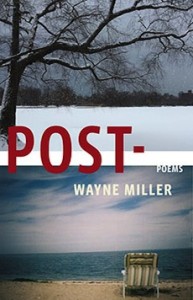Book Review
The poems in Wayne Miller’s new collection, Post-, are American. By that I do not mean that they are ready to provide a record of their citizenship, nor are they interested in dressing up as capitalized proper nouns. Rather, they are a taut lyric that briefly flashes to project an outsized picture of our country through a very small crystal. Miller uses words far more sparingly than many other poets. He is not a poet of obfuscation but of removal. In Post-, Miller’s task is to remove the fixed barrier that has separated public from private and past from present while exploring the topics of debt, violence, and family. That he so humbly succeeds at this is a testament to Miller’s status as a singular figure in American poetry.
Miller digs deep into a word and massages it for unexpected blooms. In “Debt,” Miller writes, “He entered through the doorway of his debt. / Workmen followed, bringing box after box / until everything he’d gathered in his life / inhabited his debt.” The burden of debt shifts with each new appearance of the word, rendering the American dream as a persistent deficit. From the house, debt is transferred to the automobile (“He drove into town on the coiled springs / of his debt”), to the neighbors (“The dark woods / stretching inland were pocked by lightfilled cubes / of debt”), to the intellect itself (“The very words he used to describe / his surroundings were glittering facets / of debt”). This poem wears a pained grin. Its dark humor belies how economic realities have invaded the interior, nonpublic sphere—namely, the soul. In the last crushing lines of “Post-Elegy,” the speaker is retrieving the car of a friend who has recently died. The speaker pivots from elegy in the last stanza:
I was steering homeward
the down payment
of some house we might live in
for the rest of our lives.
Miller frequently undermines interiority. He is more interested in testing the charges between the private and the public. Poetry, for Miller, exists along a spectrum of dissonance. It should be a place where sparks are made.
These sparks burn brightly in “The People’s History,” which documents a riot by shifting rapidly between the perspectives of protesters and police:
And the People surged, then, into the rows before them,
pushing the People against the blurred arcs
of truncheons, the People throwing rocks
into the plastic shield and visors,
behind which
the People blinked when the rocks hit, then pushed back
so the mass of People before them compressed.
Through his pointed repetition of “people,” Miller suggests that police violence is an act akin to self-harm, injecting a sense of crisis to the nationwide trend that we have become numb to. Reading this poem, I was reminded of the strange pleasure there is in repeating a word until it loses all sense of meaning. Pee-pul. Pee-pul. Pee-pul. Miller defamiliarizes the word and, through the chaotic events of the poem, returns it to reverence.
Still, violence seethes throughout these poems. In the haunting “21st Century Museum,” people watch explosions through closed circuit televisions that “open onto other rooms / within the building—rooms / that are unreachable / to those who bought a ticket. / When a bomb goes off / on one of the many screens / the gathering audience gasps.” The performance and consumption of violence continues in “Hoax Bomb”: “When the man in the bombsuit / lifted the box from the embankment, / most of the people / already had left.” That violence is a consumer good, and that a privileged set of spectators are able to remove themselves from the fray, is a compelling comment on the cloistered regions of violence in America’s cities.
Miller repeatedly uses spatial language to suggest how violence is sanctioned through distance: “the black beyond the windows / we pin our language to” (“21st Century Museum”); “their profiles splashed / to the light-dappled surface— / their movements / too distant from us to have meaning” (“Consumers in Rowboat”); “The ship is so close to shore / it seems ridiculous it can’t be righted. / Every day it slips a little more” (“Image: Psychotherapy”). While sanction is the function of distance, Miller also includes many fine images of its inverse. Human closeness abounds in Post-. In “Marriage,” Miller says of his wife “I arrived at the warm / engine of you / asleep beside me.” Then, in “Prayers (w/Answers),” Miller performs a captivating imitation of how affection is shared through social media. Rather than condemning the banality of a Facebook “like,” Miller incorporates it into a sincerely affecting tribute:
I’m a little embarrassed
you saw me riding that jet ski.
It made a wind
only for you. That’s why I like it.
I showed you Nag’s Head from the lighthouse.
I was there once. I like
to imagine our eyes locked into the air’s
same sockets. To see it from inside you.
In “On Breathing,” the speaker is surprised to find his breath from the previous night frozen in frost to a window. This small image, tucked neatly into the book’s ending, serves as a sort of assault on distance. Miller appears to be saying that in order to remain fully alive, one must get very close, and breathe.
About the Reviewer
Phillip Garland’s fiction has appeared in Parcel, Vol. 1 Brooklyn, Red Lightbulbs, and other places. He hails from Tennessee and lives in Chicago.
